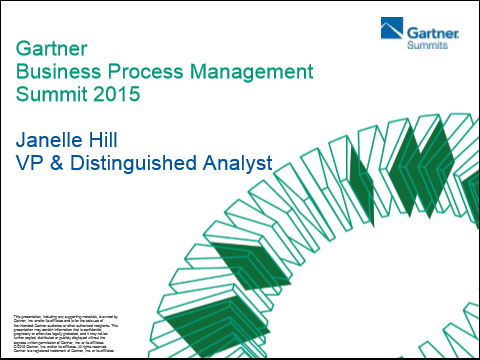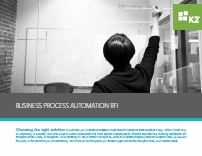Home / Resources
Resources
Discover a Wealth of BPM Knowledge and Expertise at BPMInstitute.org!

Eliminating the Strategy Execution Gap with Business Process Management
In today’s corporate circles, strategic planning and its execution are commonly identified as two separate endeavors – one is built in the boardroom, the other completed at the ground floor of the business. Leaders routinely express frustration about what is termed the strategic execution gap – how the strategy they created is rarely executed smoothly or as it was intended. At the ground level where the strategy is to be deployed, employees complain that the strategy is so vague as to be unactionable or else it is altogether misdirected. The result of such failures is strategic stagnation and lost opportunities to gain market share. While a host of theories have been proposed as to how to minimize the strategy execution gap, I believe the best approach is to eliminate it all together – to make strategic planning and execution a concretely connected endeavor using a Business Process Management toolset.

Organizational Alignment
For decades, the question that has been observed to be top of mind for many executives is “How should we be organized to be able to achieve our strategic objectives?”
Perhaps that explains why leaders select reorganization or restructuring as the single most frequently practiced method of change management. To test this out, simply ask yourself how often your company has modified the organization chart in the top two to three levels during the past three years? If you answered less than three times, you are probably in the minority.

Transforming Business Through Strategic Process Management
A recent Gartner poll of their client base found that 80% of public and private sector companies say they are undertaking major business transformation due to:
- desire to shift to digital business
- desire to become more customer/constituent-centric
- perennial activities to keep pace with regulatory changes
More than 70% of these initiatives fail to deliver the desired outcome.
Process management practitioners can defy these odds by applying the latest process and change management thinking, techniques and technologies.
Register for this webcast to get a sneak preview of what you’ll learn at the Gartner Business Process Management Summit.

Data without Process is Meaningless!
When you hear the terms “big data” or “analytics” what comes to mind?
Do you think of technical experts pushing exabytes of data through an algorithm? Perhaps you think of marketing experts attempting to get answers about your company’s customers.
No matter which scenario you think of, it is important to recognize that big data and analytics are most useful when their associated processes are in place and observed.
In fact, big data and analytics are useless without process.
Why? Because quite simply, Data without process is meaningless!

The Life Cycle of BPM Centers of Excellence – Part 1
The number of companies that have a BPM Center of Excellence (COE) has not grown over the last eight years (It’s stable at about 34% according to a BPTrends survey.). In trying to guesstimate why that might be happening, I have been asking these questions:
1. When do companies start a COE and why?
2. What do COE employees do?
3. How do COE’s change and what causes these changes?
This article focuses on the last question, but responds to the first two in the specific examples.

Balanced Scorecard: A Model for Improving Government Performance
Untitled Document
“People and their managers are working so hard to be sure things are done right, that they hardly have time to decide if they are doing the right things.” – Stephen Covey
If you’ve ever tried to keep scorecards for a high school baseball team, which I did for a couple of years a long time ago, you learn after a while to keep track of what’s really important, ignoring the occasional slip while making sure the captured data points can be used to improve the team’s overall performance. Since then, I’ve learned that well-managed enterprises, including some in government, use a similar approach.

Why is it Process Improvement Initiatives Never Quite Pan Out as Advertised?
Farah looked over a new operations process. At first glance it seemed to address some long-standing concerns she and other colleagues had. Farah ensured that she had entered into a meaningful dialogue with all of the departments to ensure that everyone had their say and agreed with the changes. Perhaps more importantly, Farah made sure that the changes in the process respected product requirements, safety regulations and her company’s quality standards.
For the first week the process seemed to work very well. Farah was very pleased to see quality improvements. Then after about three weeks of implementing the new process, Farah started noticing some hitches and hiccups. Every now and then she gently prodded an employee to more closely adhere to the new process and for a short time the employee would do so. But it seemed to Farah that within a day or so many of the employees would mix the new and old processes and the results of this were less than ideal.

Extending your enterprise – SOA vs. APIs
The nature of APIs
In a digital economy with open business ecosystems, channel experiences and backend systems evolve at different speeds. Nevertheless, an engaging experience must combine the two. Being able to see health statistics is useful, for example, but being able to do something with those statistics in the context of your personal health is the differentiator. Thus, truly engaging apps must leverage data and functions across backend systems of record as well as smart systems of insight.

Business Process Automation RFI
Business process management (BPM) needs can vary widely, from top-down business transformation initiatives to smart process applications to enterprise resource planning, marketing, social and more. With this breadth and depth of reach, BPM – and BPA, business process automation – are more than a couple of buzzwords, they are absolutely mission critical.
To get the most out of a BPM or BPA solution, organizations need to select platforms that are quick to deploy, agile once in service and show measurable value over time.
There are plenty of offerings on the market today, but, how do you compare them when they offer such varying capabilities?
We’ve created a resource to help you efficiently compare BPM and BPA solutions by identifying the most important considerations.

How to Facilitate Successful Process Mapping Sessions
Process mapping is often the first step in business process improvement. It is a necessary activity that provides a baseline from which improvements can be measured and is the key to identifying and localizing opportunities for improvement. Therefore it is important that facilitators capture the right information to help steer process improvement initiatives in the right direction.
Facilitators must possess the ability to lead (steer the direction of meetings), manage people (deal with conflicts and diversions), and persuade participants to open up and share the knowledge they possess to have successful mapping sessions. This can be challenging when dealing with large groups and complicated processes. Following the guidelines outlined in this article can help to ensure that you have a successful process mapping session.

Leadership as a Process
Cora was new at her position and her company. She had been brought in to manage a project that was not performing well. The project was well behind its deadlines and so over budget it amazed Cora that the company still wanted to go ahead with it. Knowing that there would be a lot of pressure on Cora and her team to salvage the project, Cora set her mind to getting to know as much as possible about the project from day one.
It was obvious to Cora that the team had tried many solutions and strategies and all of them failed. The team knew the goal but not the way to achieve it. So for the first days she listened. She went to see each and every one of her team members to introduce herself, get to know them a little bit, and get their take on what was happening with the project.

Responsive Business Architecture
Responsive web design is fast becoming a mantra in the digital media design. The idea is to create compelling experiences that adeptly respond to how a person interacts with digital media. It doesn’t matter what device I use to browse an electronic commerce website; the form and content should make it easy for me to find what I’m looking for. And maybe buy more of their products, more often.
I make the same case for responsive business architecture. As a decision-maker, I need all the tools, techniques, and information I can get to make the most-informed decisions on a daily basis. Decision making is both an art and science. I can turn to a business architect and listen to the options available to me. And I can ask my lawyer, accountant, fellow Board members, or any subject matter expert for their opinions. In the end, I synthesize data and information to come up with the best possible decision at that time.

Houston, We Have A Problem: Why Effective Communication is a Key Component for BPM Efforts
Do you wonder why some BPM efforts seem to proceed more smoothly? Stakeholders have provided clear directions regarding improvements. The project manager has the pulse of all the activities happening on the project. The process owners and technical experts are collaborating and making changes to processes that will enable the organization to improve its operations substantially.
No this isn’t someone’s dream, and it does happen, albeit rarely!
Project members’ poor communication is one of the reasons business process efforts aren’t more successful. In fact, failure is virtually ensured if just one of these groups doesn’t communicate clearly.
Good communicators know before they open their mouths what they want to convey. They are clear about the message they want to communicate. Accomplished communicators are specific and use words and language that resonates with their listeners.

What to do in BPM When You are Starting, Growing or Dying
STARTING:
- Are you ready to look at your work from a customer’s perspective?
- Do you want to streamline workflows to increase your competitive advantage?
GROWING:
Have you been doing process improvement projects for more than a year? Now…
- Do you want to take your organization to larger returns—seeing the benefits of end-to-end improvements?
- Would you like to build continuous improvement behaviors into daily management and employee life?
DYING:

Leveraging Organizational Knowledge with Decision Modeling
Organizational decisions are not as effective because we have not been able to explicitly connect organizational Knowledge to decisions. Formal decision modeling helps deploy existing knowledge and highlights knowledge gaps that need to be filled.
Knowledge is diffused across the organization
How do we know if we are making good decisions? When we are confident that we have used all available knowledge in making that decision.
How can we tell if our knowledge is good or bad? There is no clear measure of knowledge but its value is understood and appreciated. We know that there is a lot of effort and investment in increasing organizational knowledge. Procedure Manuals, Training Programs, Collaboration Sites, Intranets, Portals, Share point and others are all geared towards making organizations better through pooling and managing the communal knowledge.
Decision makers are supposed to become knowledgeable on their own

Shared Services: A Model for Achieving Government Efficiencies
“I think many [agencies] would greatly benefit from a top-to-bottom efficiency analysis . . . done by people who understand government. The results of such an analysis . . . can provide a menu of choices for . . . officials as they work through the real nitty-gritty issues of efficiency in government.” – John R. Bartle, dean of the College of Public Affairs & Community Service at the University of Nebraska at Omaha

Want to Supercharge Innovation? Map your Customer’s Processes!
Remember when you had to purchase your music via cd’s, records, or cassettes at brick and mortar record stores? Prior to the iPod’s arrival, there was always a delay between the intent to purchase the songs we wanted and the time when we could actually enjoy them. The delay was either the travel time to and from a store to buy the album or the time waiting for an order placed online to arrive from the post office. There definitely wasn’t instant gratification in the process. The purchasing channels were rigid – requiring us to buy in increments of albums instead of choosing the exact songs we wanted. But there wasn’t an outcry from consumers. We learned to live with the shortcomings of the process. But then came revolutionary change.

Making Decisions Operational
My last posting (“Transitioning to a World of Decisions”) began presenting observations of decision modeling, implementation and management as they have moved from theory to practice. These observations have been made from both the Business and IT sides of the Enterprise. Although the sample size is still relatively small, some definite trends are beginning to take shape. While the previous article focused primarily on testing, I also alluded to some difficulties arising from a strict reliance on using decision tables for ALL rules. I have observed this on several projects.

Just in Time Process Modeling
One of the persistent criticisms of BPM is that the process definitions are too rigid to accommodate the realities of modern business. This can deter organizations from properly evaluating how BPM can help them. The reality is that most BPM tools offer a range of options for building highly flexible and adaptable processes. In this article, we will briefly explore some of these.

BPM – How to Make It Stick
How to make BPM stick is one of the most frequently asked questions by participants at BPMInstitute.org. How is it possible to engage everyone in following the re-designed process and how best to assure continuous improvement of the new process are just two of the questions that come up regularly.
While making BPM stick is just as much art as it is science, there are some important guidelines to note around enablers such as transparency, advocacy, alignment and accountability as well as some key pitfalls to avoid. These are outlined below.













